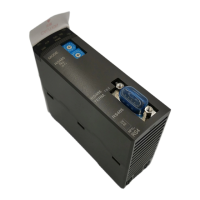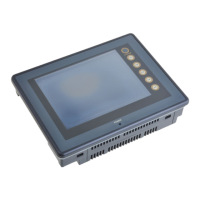1-48
Section 1 Specications
No. Keyword Data type No. of bits Value range
1 BOOL Boolean 1 0 or 1
2 INT Integer 16 -32,768 to 32,767
3 DINT Double integer 32 -2,147,483,648 to 2,147,483,647
4 UINT Unsigned integer 16 0 to 65,535
5 UDINT Unsigned double integer 32 0 to 4,294,967,295
6 REAL Real 32 -2
128
< N <= -2
-126
, 0, 2
-126
<= N < 2
128
(single-precision oating point)
7 TIME Duration 32 0ms to 4,294,967,295ms (0ms to 49 days, 17:02:47s295ms)
8 DATE Date 32 January 1st, 1970 to February 7th, 2106
9 TOD Time of day 32 0:00:00 to 23:59:59
10 DT Date and time of day 32 January 1st 0:00:00, 1970 to February 7th 6:28:15, 2106
11 WORD Bit string of length 16 16 16#0000 to 16#FFFF
12 DWORD Bit string of length 32 32 16#00000000 to 16#FFFFFFFF
1-6-2 Basic data types
Basic data types refer to data whose value range and bit count are dened by IEC 61131-3. The MICREX-SX series SPF
supports the following basic data types:
Notes:
1) 16# represents a hexadecimal number.
1) BOOL (Boolean)
The minimum unit of data that can be represented by a single memory bit (0 or 1).
Examples: BOOL#0, BOOL#1, TRUE, FALSE
2) INT (Integer)
An INT occupies 16 memory bits (1 word) and handles integer values from -32768 to 32767.
Examples: -1000, 0, 12345, INT#1234, INT#16#FF0F
3) DINT (double integer)
A DINT occupies 32 memory bits (1 double word) and handles integer values from -2147483648 to 2147483647.
Examples: DINT#12345678, DINT#16#F000F00F
4) UINT (unsigned integer)
A UINT occupies 16 memory bits (1 word) and handles integer values from 0 to 65535.
Examples: UINT#1000, UINT#16#FFFF
5) UDINT (unsigned double integer)
A UDINT occupies 32 memory bits (1 double word) and handles integer values from -0 to 4294967295.
Examples: UDINT#100000, UDINT#16#111FFFF
6) REAL (real <single-precision oating point>)
A REAL occupies 32 memory bits and handles real values of - 2
128
< N <= - 2
-126
, 0, 2
-126
<= N < 2
128
(-3.4028235E + 38 to -1.1754945E - 38, 0, 1.1754945E - 38 to 3.4028235E + 38).
Notes:
1) The value range of REAL type data with guaranteed accuracy is basically 6 signicant digits. However, this may be lowered
to 5 digits or less in some numeric FCTs. For details, see the individual instruction descriptions.
Examples: -10.035, 0.0, 0.2345, REAL#10.0
-1.34E - 12, 1.0E + 6, 1.234E6
-1.34e - 12, 1.0e + 6, 1.234e6
2) Real values that are smaller than the minimum representable value (±2
-126
) are handled as zeros (0).
f
May be represented in exponential formats.
A contact or coil in LD language is an example of BOOL data.

